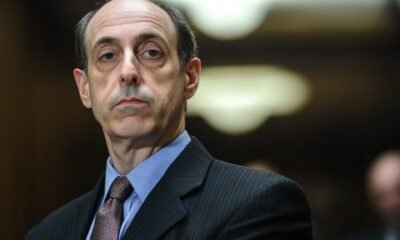Finance
Crypto firms warned North Korean hackers posing as IT workers experts say dual wallets and AI could be the only defense
Cybersecurity experts say North Korean operatives are infiltrating crypto companies by posing as developers, urging firms to adopt dual wallet management, AI-driven monitoring, and strict employee vetting.

The crypto industry is once again in the crosshairs of North Korean cybercriminals — but this time, experts warn the threat may come not from distant malware campaigns, but from inside company walls.
According to cybersecurity specialists, North Korean agents are seeking jobs at major Web3 firms under fake identities, aiming to gain insider access that could lead to large-scale exploits. The risk is more than hypothetical. Earlier this year, the Coinbase data breach exposed sensitive information about nearly 1% of users, including wallet balances and even physical locations, costing the exchange an estimated $400 million in potential reimbursements.
ALSO READ : Big Brother Season 27 finale crowns Ashley Hollis as winner while Keanu takes America’s Favorite Houseguest
How North Korea infiltrates crypto
Fake resumes, aliases, and forged documents are now tools of choice for operatives seeking to embed themselves within blockchain companies. Once inside, these workers can extract sensitive data, siphon funds, or pave the way for future hacks.
“Organizations need to treat the DPRK IT worker risk seriously,” said Yehor Rudytsia, head of forensics and incident response at blockchain security firm Hacken. He stressed the need for thorough background checks and strict role-based access controls.
Rudytsia also pointed to industry standards like CCSS (Cryptocurrency Security Standard) for wallet operations, urging companies to adopt dual wallet control, where multiple signatories are required for a transaction, reducing the risk of a rogue insider.
AI as the new frontline
Beyond wallet management, experts argue artificial intelligence must be integrated into crypto security systems. Deddy Lavid, CEO of blockchain cybersecurity firm Cyvers, told Cointelegraph that “real-time, AI-driven monitoring is how to stop the next breach.”

Lavid emphasized that AI-powered anomaly detection, linking both on-chain and off-chain data, could alert firms before an insider exploit escalates. “The Coinbase breach was a warning,” he added. “Proactive AI monitoring can prevent the next one.”
Alarming discoveries
The urgency of these warnings was underscored by revelations from Security Alliance (SEAL), an ethical hacker collective that uncovered at least 60 North Korean agents posing as IT professionals. The repository of data published by SEAL included fake resumes, forged citizenships, email addresses, and even records of firms that had unknowingly hired these operatives.
Just last June, four North Korean infiltrators were confirmed to have landed freelance roles at multiple crypto companies, raising fears of more sophisticated, long-term campaigns.
Binance founder raised alarm
The growing infiltration threat has also caught the attention of industry leaders. Changpeng Zhao, co-founder of Binance, publicly warned about the risks of hiring unknown developers without rigorous checks, noting how bribes and fake credentials are being used to slip through recruitment processes.
A global cybercrime problem
While not every North Korean developer is a hacker, experts highlight that wages paid to such workers often end up funding the state, which has become one of the world’s most notorious cybercrime actors. According to the United Nations, North Korea has stolen billions of dollars in cryptocurrency over the past decade to fund its weapons program.
What companies must do next
The solution, according to experts, is multilayered:
- Dual wallet management with multisignature safeguards.
- Enhanced employee vetting with identity verification and background checks.
- Real-time AI monitoring to detect unusual activity before it escalates.
- Regular audits of cloud setups, logs, and wallet operations.
As Rudytsia put it: “The key is simple: keep verifying, keep monitoring, and don’t rely on trust alone.”
With North Korea’s cyber armies growing more sophisticated, the message to crypto companies is clear: insider threats may be the next frontier, and ignoring them could be far costlier than preparing for them.
Finance
Derrimut 24:7 Gym collapse deepens as $30 million properties head for sale amid mounting debts
As the fitness giant struggles under $12.5 million in unpaid taxes and supplier claims, receivers move to sell Derrimut’s flagship sites in Melbourne — while members complain of “filthy gyms and broken promises.”

The financial meltdown surrounding Derrimut 24:7 Gym has entered a new and alarming phase, as receivers move to sell three of its largest properties in Melbourne in a desperate bid to recover spiraling debts. What was once hailed as a powerhouse in Australia’s fitness industry now stands on the edge of collapse — tangled in unpaid taxes, angry creditors, and frustrated gym members.
According to The Age, two of Derrimut’s major gyms — located in Thomastown and Ravenhall (marketed as Caroline Springs) — along with its corporate head office in the suburb of Derrimut, have been placed on the market by appointed receivers Rodger Reidy. Expressions of interest for the properties are due by 4 December, with the total sale expected to fetch around $30 million.
While Derrimut leases most of its 24 nationwide gym locations, these three sites are owned by entities linked to its founder Nick Solomos. Sources indicate that Solomos has been scrambling to secure new financing to stop the company’s liquidation, even as the Australian Taxation Office (ATO) pursues court action over more than $12.5 million in unpaid tax, superannuation, and penalties.
The ATO’s liquidation case against Derrimut’s main trading entity has already been adjourned several times by the Federal Court of Australia, giving the embattled founder time to raise emergency funds. However, as the situation worsens, the window of opportunity seems to be closing fast.

Adding to Derrimut’s financial woes, a growing list of high-profile suppliers and partners — including Life Fitness, Bench Fitness, Melbourne United Basketball Club, ReturnToWorkSA, AGL Energy, and Del-Re National Food Group — have joined the creditor action, collectively demanding over $2 million.
In September, The Age reported that Derrimut had failed to pay hundreds of suppliers, landlords, and even staff superannuation. More shockingly, millions of dollars were allegedly withdrawn for personal use, including luxury vehicles, mortgage payments, and weekly cash allowances for senior management.
Meanwhile, the company’s once-loyal members — estimated at over 200,000 across Australia — are voicing growing frustration over deteriorating gym standards. Online reviews and social media complaints describe “dirty showers,” “broken equipment,” and “missing essentials like toilet paper and hand towels.” Some reports even allege WorkSafe Victoria flagged concerns about hygiene and maintenance standards.
Ironically, even amid these complaints, Derrimut’s gyms in Thomastown and Ravenhall were still promoting aggressive membership offers this week — including an annual plan for $399 on social media. Many users called the promotions “tone-deaf,” given the chaos unfolding behind the scenes.
In South Australia, Derrimut is facing yet another crisis. The company is currently in dispute with a landlord attempting to close its Melrose Park location, while a construction firm, Ikonstruct SA, has demanded payment for unfinished building works.

As the storm rages, one name has emerged as a potential savior — businessman Adrian Portelli, widely known as the “Lambo Guy” for his luxury car giveaways and flamboyant public persona. Portelli confirmed last month that he was in talks to acquire a stake in Derrimut, although he admitted the deal was far from finalized.
“We haven’t put pen to paper just as yet,” Portelli said, “but work has begun in the background.”
He went on to describe Derrimut’s corporate setup as “a very complex structure with multiple entities,” hinting that any acquisition or rescue deal would involve untangling a web of financial relationships and ownership layers.
Industry experts warn that even a high-profile investor like Portelli may find it difficult to revive Derrimut’s reputation, given the depth of its debts and the mounting legal challenges. Insolvency experts note that once the ATO begins winding-up proceedings, it becomes difficult for companies to recover unless new ownership and funding are secured almost immediately.
Still, many long-time members and staff are holding onto hope that the iconic brand — famous for its slogan “No Judgement, Just Results” — can somehow find a second wind. Derrimut 24:7 Gym was once celebrated as a homegrown Australian fitness success story, with massive facilities, affordable memberships, and an energetic social media presence that helped build a cult-like following.
Today, however, that story stands as a cautionary tale about rapid expansion, financial mismanagement, and the dangers of blurred lines between business and personal spending.
As the receivership process unfolds and offers roll in, the coming weeks could determine whether Derrimut 24:7 Gym survives as a brand — or becomes another footnote in Australia’s turbulent fitness industry.
For ongoing updates and more breaking stories like this, visit www.DailyGlobalDiary.com.
Finance
UK takes bold step into digital money six major banks join tokenized sterling deposits pilot what it means for the future…

The United Kingdom is officially testing the waters of tokenized money. On Friday, UK Finance, the powerful trade association representing more than 300 financial services firms, announced the launch of its tokenized sterling deposits (GBTD) pilot, marking a major step in the digital transformation of banking.
The project — which will run until mid-2026 — is designed to create a digital representation of the British pound issued by commercial banks, potentially revolutionizing how money moves across the financial system.
ALSO READ : Bad Bunny to headline Super Bowl LX halftime show marking a historic moment for Latin music
Six of the UK’s biggest banks are participating: Barclays, HSBC, Lloyds Banking Group, NatWest, Nationwide and Santander. Together, these institutions represent the backbone of Britain’s financial landscape.
Why tokenized deposits matter
Tokenized deposits are not cryptocurrencies or stablecoins. Instead, they are blockchain-based digital versions of existing pounds held in commercial banks. Unlike volatile crypto assets, tokenized deposits are fully backed by fiat currency, making them stable and familiar to regulators.
UK Finance believes the initiative could bring multiple benefits:
- Faster payments across online marketplaces
- Fraud prevention through programmable transactions
- Efficiency in wholesale bond settlement and remortgaging
By digitizing bank money, the pilot could improve security and create new possibilities for programmable finance, a step closer to the concept of “smart money.”

Quant Network behind the tech
The infrastructure for the project will be delivered by Quant Network, a UK-based blockchain interoperability firm led by founder and CEO Gilbert Verdian.
“Our involvement underscores Quant’s leadership in digital finance,” Verdian said. “This project isn’t just about faster payments — it’s about enabling programmable money that can fundamentally transform how value is moved and managed.”
Quant previously helped deliver the Regulated Liability Network (RLN), another UK-led shared ledger initiative launched in 2024, which brought together global giants like Citi, Mastercard, Visa, and Standard Chartered.
UK catching up on regulation
The tokenized deposits pilot comes as the Financial Conduct Authority (FCA) prepares to roll out a comprehensive crypto regulatory framework by 2026. Earlier this year, the UK Treasury issued a policy note clarifying that tokenized deposits and stablecoins would be regulated differently from traditional e-money.
Meanwhile, the European Union has already implemented the Markets in Crypto-Assets (MiCA) regulation, which broadly governs tokenization but excludes deposits tied to traditional banking. That leaves the UK’s approach under the spotlight as it looks to position itself as a hub for digital finance.
Three key use cases
According to UK Finance, the pilot will focus on three main areas:
- Online marketplace payments – faster, fraud-resistant transactions.
- Remortgaging processes – streamlining paperwork and settlement.
- Wholesale bond settlement – reducing friction in financial markets.
If successful, these use cases could provide a roadmap for wider adoption of tokenized deposits, reshaping the daily interactions of consumers, banks, and businesses.
The bigger picture
The push for tokenized deposits underscores a global race among governments and banks to modernize money. While central bank digital currencies (CBDCs) like the proposed Digital Pound are still under discussion, private-sector pilots like this could accelerate innovation without waiting for government rollout.
For now, the UK’s experiment with tokenized sterling deposits will be closely watched. As Gilbert Verdian put it: “We are building the infrastructure powering tomorrow’s economy.”
Finance
SEC’s ‘Crypto Mom’ Hester Peirce jokes about NFTs after tenure hints at softer future for digital assets…
At a Coin Center event, SEC Commissioner Hester Peirce joked about launching her own NFT collection after leaving the agency, while reflecting on crypto policy shifts following Gary Gensler’s departure.

Hester Peirce, widely known in the digital asset community as “Crypto Mom,” offered a blend of humor and hard truths during her recent remarks at a Coin Center event. With her official term at the U.S. Securities and Exchange Commission expiring in June, speculation has swirled about her next career move.
Addressing the audience, Peirce dismissed the idea of pivoting to the private crypto sector like many former regulators, saying:
ALSO READ : Barack Obama blasts Trump over Tylenol autism claim calling it ‘violence against truth’ but that’s not all he said…
I could leave the government and do a 180 on crypto, but that career path is too well-trodden for me.
Instead, she joked about turning to beekeeping — “honey is delicious and nutritious, and bees sting with less glee than most of my Twitter commenters” — before delivering her punchline:
For post-SEC life, therefore, I must turn to Plan C, or more precisely, Plan NFT.
Peirce said her tongue-in-cheek NFT collection would feature caricatures of the many characters she has encountered in the crypto ecosystem, from CEOs and influencers to regulators and skeptics.
A serious message behind the humor
While her NFT remarks drew laughs, Peirce quickly turned serious. She acknowledged that much of her tenure had been a struggle to convince colleagues to give the crypto industry a fair chance.

“I am sorry that over most of my tenure at the SEC I failed to convince my colleagues in government to give you a chance,” Peirce admitted. “I hope that you and others whom you have inspired will use this time… to build good things that will enhance the safety, security, happiness, and prosperity of your family, friends, neighbors, and nation.”
SEC’s shifting crypto stance
Her comments come at a time when the SEC’s tone on digital assets appears to be softening. Since the January departure of former SEC Chair Gary Gensler — often criticized for pursuing “regulation by enforcement” — the agency has scaled back some long-standing lawsuits against crypto companies.
Analysts suggest this shift could pave the way for long-awaited approvals of cryptocurrency exchange-traded funds (ETFs), a development that might legitimize the industry in the eyes of traditional investors.
A market structure bill moving through the U.S. Senate is also expected to clarify the roles of financial regulators, potentially giving the SEC more defined responsibilities in overseeing digital assets.
Why Peirce matters to crypto
As one of the most vocal advocates for blockchain innovation within the SEC, Peirce has earned respect in the crypto community. Her balanced approach — skeptical but supportive of experimentation — has set her apart from more hardline regulators.

By floating lighthearted NFT ideas while stressing the importance of regulatory clarity, she struck a chord with both policymakers and innovators.
For the industry, Peirce’s eventual departure will mark the end of an era. But her parting words were a reminder that she sees the current moment as a critical opportunity:
Regulatory clarity has replaced ambiguity as government’s objective — now it’s up to you to build responsibly.
Whether or not she ever mints her “Crypto Mom” NFTs, Peirce’s legacy will be remembered as one of the few regulators who tried to bridge Washington with Web3.
-

 US News1 week ago
US News1 week ago“She Never Made It Out…” Albany House Fire Claims Woman’s Life as Family Pleads for Help to Bring Her Home
-

 Entertainment1 week ago
Entertainment1 week agoXG Star Cocona Shares a Brave Truth at 20 — “I Was Born Female, But That Label Never Represented Who I Truly Am…”
-

 Entertainment1 week ago
Entertainment1 week agoSamba Schutte Reveals the Surprise Cameo in Pluribus That “Nobody Saw Coming”… and Why John Cena Was Perfect for the Role
-

 Entertainment5 days ago
Entertainment5 days agoSaudi Arabia’s entertainment revolution… Red Sea Film Foundation CEO Faisal Baltyuor says he ‘wears many hats’ — but one mission drives them all
-

 Entertainment1 week ago
Entertainment1 week agoMandy Moore Signs On for a Bold New Peacock Erotic Thriller — “A Twisted Game Where the Student Becomes the Teacher…”
-

 Entertainment3 days ago
Entertainment3 days agoAmy Schumer and Chris Fischer Split After 7 Years of Marriage — Inside Their ‘Cohesive’ and Amicable Divorce
-

 Politics6 days ago
Politics6 days ago“If I Can’t Beat Jimmy Kimmel, I Shouldn’t Be President…” Trump Drops Bold Claim Ahead of Hosting Kennedy Center Honors
-

 Entertainment6 days ago
Entertainment6 days ago“Heartbreaking… Devastating… Deaths”: ‘It—Welcome to Derry’ Creators Hint at a Finale Fans Aren’t Ready For




























